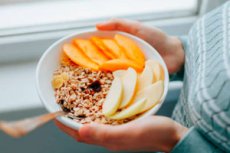New publications
Scientists have discovered how fiber-rich foods contribute to feelings of satiety
Last reviewed: 02.07.2025

All iLive content is medically reviewed or fact checked to ensure as much factual accuracy as possible.
We have strict sourcing guidelines and only link to reputable media sites, academic research institutions and, whenever possible, medically peer reviewed studies. Note that the numbers in parentheses ([1], [2], etc.) are clickable links to these studies.
If you feel that any of our content is inaccurate, out-of-date, or otherwise questionable, please select it and press Ctrl + Enter.

A study published in the journal Science Translational Medicine by scientists at Imperial College London found that a high-fibre diet stimulates the release of an important appetite-reducing hormone in the ileum, a part of the small intestine.
The peptide tyrosine-tyrosine (PYY), known for its effects on reducing appetite and food intake, is released in large quantities from ileal cells when people consume a high-fiber diet.
The ileum, the longest part of the small intestine, plays an important role in regulating appetite by secreting enzymes and hormones, but until now little was known about how it interacts with different types of food.
The researchers also identified key metabolites - small molecules produced by the breakdown of food - that promote the release of PYY, opening up an interesting possibility for developing hunger-suppressing foods.
In the study, a small group of healthy volunteers were asked to consume a variety of meals, including high- and low-fiber foods such as apples, chickpeas, carrots, sweets, and white bread, for four days. The participants had nasoendoscopic tubes inserted into their small intestines, allowing researchers to take samples of chyme, a substance produced in the small intestine, before and after eating.
The researchers found that the environment inside the ileum is much more reactive to fasting and feeding than previously thought. They also found that high-fiber foods altered the microbiome and stimulated PYY release from ileal cells more than low-fiber foods.
This was observed even when high-fiber foods were pureed, such as chickpea puree or apple juice.
Molecules such as stachyose and the amino acids tyrosine, phenylalanine, aspartate, and asparagine, which are commonly found in foods such as beans, cheese, meat, and poultry, promote the release of PYY.
Dr Aygul Daghbasi, from Imperial College London, one of the lead authors of the study, said: "We now understand how dietary fibre is associated with lower levels of hunger compared with a low-fibre diet, and that certain fibres and amino acids stimulate PYY. For example, oats and legumes are high in fibre and a good source of protein, so are good foods for increasing satiety."
Developing Healthy Diets Access to the deep portions of the human gastrointestinal tract is difficult, so this study represents a step forward in scientists' understanding of the role of the ileum.
Professor Gary Frost, from Imperial College London, a co-author of the study, explains: "Our research not only provides a more detailed understanding of how the ileum continually changes in response to fasting and feeding, but also has implications for the development of healthier diets. If we can find ways to deliver specific foods to the right parts of the gut, it could help people struggling with weight control to better control their appetite and stick to their diets."
